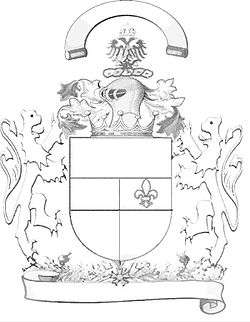Dexter and sinister
| Part of a series on |
| Heraldic achievement |
|---|
|
Conventional elements of coats of arms |

Dexter and sinister are terms used in heraldry to refer to specific locations in an escutcheon bearing a coat of arms, and to the other elements of an achievement. "Dexter" (Latin for "right")[1] means to the right from the viewpoint of the bearer of the shield, i.e. the bearer's proper right, to the left from that of the viewer. "Sinister" (Latin for "left")[1] means to the left from the viewpoint of the bearer, the bearer's proper left, to the right from that of the viewer.

Significance
The dexter side is considered the side of greater honour, for example when impaling two arms.
Sinister is used to mark that an ordinary or other charge is turned to the heraldic left of the shield. A bend sinister is a bend which runs from the bearer's top-left to bottom-right, as opposed to top-right to bottom-left.[2] As the shield would have been carried with the design facing outwards from the bearer, the bend sinister would slant in the same direction as a sash worn diagonally on the left shoulder.
This division is key to dimidiation, a method of joining two coats of arms by placing the dexter half of one coat of arms alongside the sinister half of the other. In the case of marriage, the dexter half of the husband's arms would be placed alongside the sinister half of the wife's. The practice fell out of use as early as the 14th century and was replaced by impalement, as in some cases it could render the arms cut in half unrecognizable[3] and in some cases it would result in a shield that looked like one coat of arms rather than a combination of two.
The Great Seal of the United States features an eagle clutching an olive branch in its dexter talon, and arrows in its sinister talon, indicating the nation's intended inclination to peace. In 1945, one of the changes ordered for the similarly arranged Flag of the President of the United States by President Harry S. Truman was having the eagle face towards its right (dexter, the direction of honor) and thus towards the olive branch.[4][5]
Origin
It is certain that the sides of a shield were originally named for the purpose of military training of knights and soldiers long before heraldry came into use early in the 13th century, thus the only viewpoint which was relevant was the bearer's, the front of the purely functional shield being originally undecorated. It is likely that the use of the shield as a defensive and offensive weapon was almost as developed as that of the sword itself, and therefore the various positions or strokes of the shield needed to be described to students of arms. Such usage may indeed have descended directly from Roman training techniques spread throughout Roman occupied Europe and continued during the age of chivalry during which heraldry came into use.
References
- 1 2 Cawley, Kevin; Florin Neumann; Matt Neuberg; Lynn Nelson (2012). "Latin Dictionary and Grammar Aid". University of Notre Dame Archives. Retrieved 2012-09-04.
- ↑ Friar, Stephen, ed. (1987). A New Dictionary of Heraldry. London: Alphabooks Ltd./A & C Black Plc. p. 58. ISBN 0 906670 44 6.
- ↑ Woodcock, Thomas; Robinson, John Martin (1988). The Oxford Guide to Heraldry. Oxford University Press. p. 118. ISBN 0-19-211658-4.
- ↑ Truman issued Executive Order 9646 on October 25, 1945
- ↑ Patterson, Richard S.; Dougall, Richardson (1978). The Eagle and the Shield. Washington, D.C.: Department of State. pp. 443–447. OCLC 4268298.
